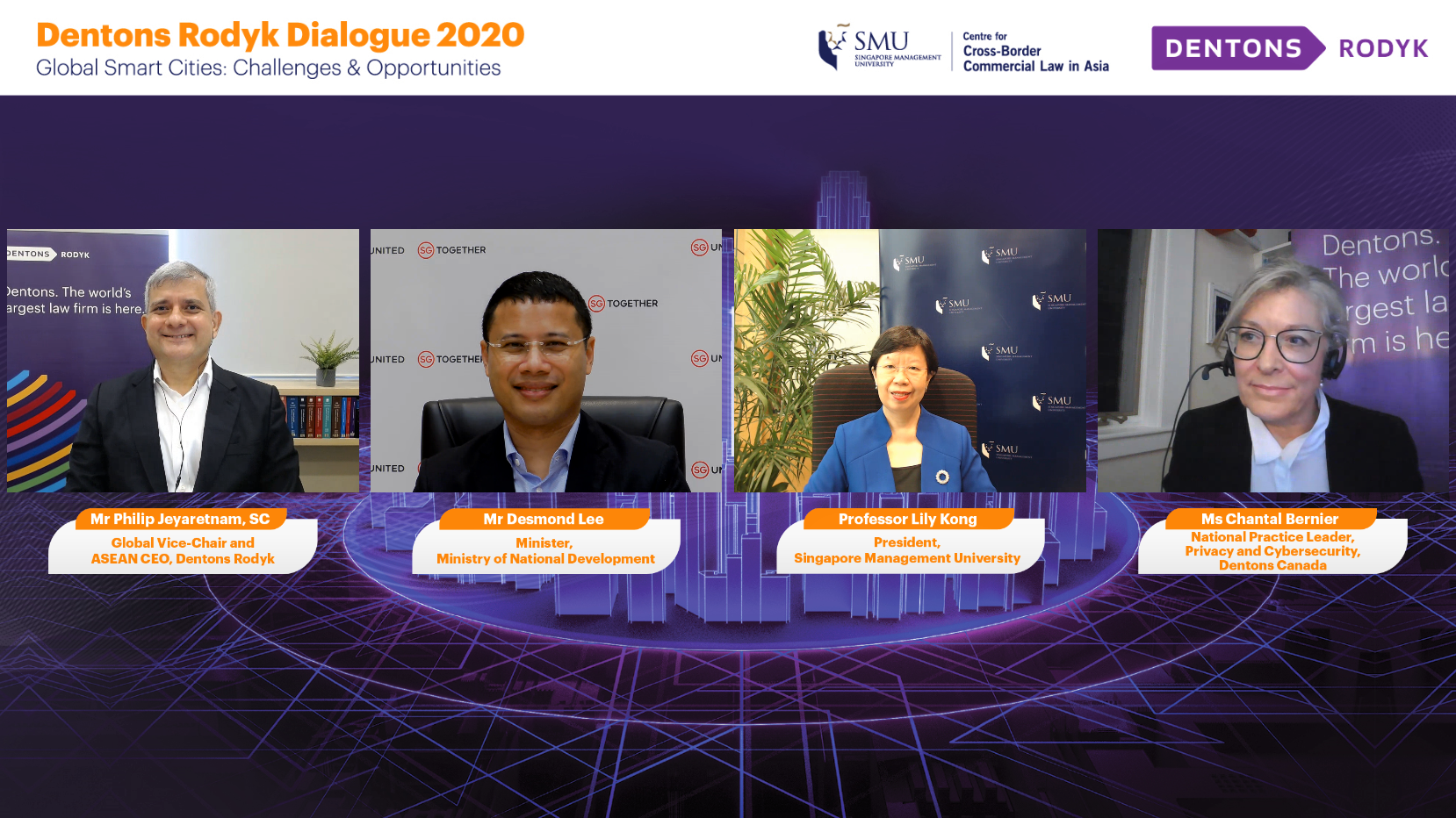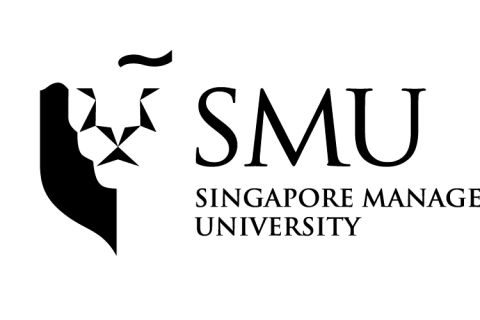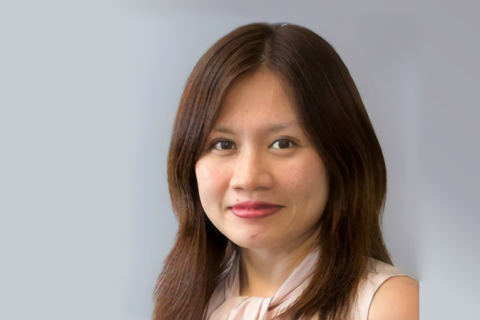
By Ng Yi-Di
SMU Office of Research & Tech Transfer – Although cities and urban areas only make up a small proportion of the world’s land mass, they are home to more than half the global population and that number is going to keep rising. As cities swell to capacity with more and more inhabitants, city planners have turned to technology to cope with the challenges that accompany urban density.
The role of digital technologies in overcoming urban development challenges have become even more apparent in the COVID-19 pandemic, said Mr Desmond Lee, Minister for National Development and Minister-in-charge of Social Services Integration.
“This pandemic has starkly shown us that we need to transform the way we design, build and maintain our city so that we move away from a heavy reliance on manpower and labour, [and that] the use of digital tools and technology has a potential to create good jobs and opportunities for Singaporeans,” Minister Lee said.
Minister Lee was the guest of honour at the Dentons Rodyk Dialogue 2020, held online on 25 September 2020. A partnership between Singapore law firm Dentons Rodyk and Singapore Management University’s (SMU) Centre for Cross-Border Commercial Law in Asia (CEBCLA), the yearly Dialogue serves as a forum for thought leaders to share ideas and interrogate key trends shaping the future. This year, the Dialogue explored the opportunities and challenges posed by the rise of global smart cities, and was moderated by Mr Philip Jeyaratnam, Global Vice Chair and ASEAN CEO, Dentons Rodyk.
Planning for people in Singapore and beyond
“Even before COVID-19, many cities including Singapore had already been striving to deal with increasingly complex and global problems,” Minister Lee said. “We have harnessed data and digital tools to better plan and design urban Singapore, and make our city more green, liveable and sustainable.”
Some of the technologies Singapore has employed to overcome the challenges of living in a densely populated city state includes the Housing & Development Board’s (HDB) Smart Hub, a central data repository which acts as a ‘brain’ for municipal operations to help HDB’s planners better understand the usage patterns of common amenities.
HDB also uses environmental modelling tools and computer simulations to analyse wind flow, solar heat and noise within towns to design and position homes in a manner that conserves energy and optimises resident comfort. “Singapore is an equatorial and very densely urban country, and these technologies can bring about real benefits,” said Minister Lee.
These benefits are a topic of particular interest to SMU President Professor Lily Kong, a social scientist who has studied the impact of technologies in smart cities on their inhabitants’ lives. In her keynote presentation, Professor Kong explained how the ASEAN Smart Cities Network (ASCN), a network of 26 cities established in 2018 to foster cooperation on smart city development, could best promote the use of smart technologies as a method of city management.
Considering the challenges
While it is tempting to think that digital solutions could be a panacea for problems caused by rapid urbanisation and urban density, it may be necessary to get a deeper understanding of the challenges involved, she said.
“There is the antecedent challenge, the issue of divergent infrastructural developments, privatisation and formalisation of city spaces, power and inequality, vertical and horizontal integration, and the balance between speed and efficacy,” said Professor Kong. “These challenges are rooted largely in a single danger – that we forget that cities are not passive backdrops for digital technologies,” she said.
In explaining each of the challenges, Professor Kong also stressed the importance of not neglecting material infrastructure development in favour of its digital counterparts. “Efficient bus timetables and smart traffic lights are no substitute for wider roads and fewer potholes,” she explained, adding that overemphasising digital development could distract from material improvements and exacerbate existing inequalities.
“Nothing as powerful as technology can be implemented without some impact,” added the next speaker, Ms Chantal Bernier, National Practice Leader, Privacy and Cybersecurity at Dentons Canada. “Many of these digital innovations are predicated upon the use of personal information, which is where privacy law is engaged.”
While governments are allowed to process personal data without consent when it is necessary, Ms Bernier said that the possibilities afforded by current data collection methods are so immense and varied that the line between necessary to collect and simply convenient have started to blur. According to privacy laws, personal data collected for one purpose cannot be used for another purpose; however, there have been examples of government technology being used by third parties without consent.
“During the London 2012 Olympics, one of the security measures introduced was smart bins with the capacity to push notifications of security alerts to devices of people passing by,” she explained. “That was certainly a laudable objective – except that in 2013 it was discovered that a private sector actor was using it to push advertisements, which is inconsistent with the reasons why the bins had been put in.”
“Go slow and go small”
Privacy concerns aside, another key consideration for smart city technologies is that they should be inclusive, said Minister Lee. “In our anxiety to go digital, we should not leave behind a whole generation of citizens,” he said, sharing the example of a 90-year-old man who requested for help but was directed to a website he was unable to read.
Agreeing, Professor Kong shared that the most important strategy for governments is to focus on the real needs of people. Such inclusive and critical thinking is key to ensure no segment of the population is left behind, she said.
“If we're not addressing fundamental issues in society, then introducing a form of tracking and formalisation actually exacerbates some of the challenges that the poor face,” Professor Kong said, citing the example of how, in a particular Third World City context where smart technology was introduced, formal GPS tracking of garbage truck routes prevent their drivers from engaging in simultaneous work on the side to make ends meet.
But for all the challenges that may undermine the transition to smarter cities, there is still plenty of impetus for Singapore to push forward with its digitalisation efforts. “In the coming years, technology and digitalisation will play an even greater role in the life cycle of the urban built environment and infrastructure that we enjoy today,” said Minister Lee. “Becoming a smart nation, making it a reality, and bringing everyone along with it, is integral to our future.”
To navigate the challenges in the journey towards this digital future, Professor Kong had two pieces of advice: go slow and go small. “Go slow to minimise the potentially negative effects that come with speed,” she said. “Smart solutions are not quick fixes to systemic problems; they are a catalysing glue that is only as effective as the policy regime and material environment within which it is deployed.”
“Second, go small to minimise the potentially negative effects of transformation. Compared to major transformations, small incremental steps are often more in sync with the material conditions of the city in question.”
Back to Research@SMU Nov 2020 Issue
See More News
Want to see more of SMU Research?
Sign up for Research@SMU e-newslettter to know more about our research and research-related events!
If you would like to remove yourself from all our mailing list, please visit https://eservices.smu.edu.sg/internet/DNC/Default.aspx

